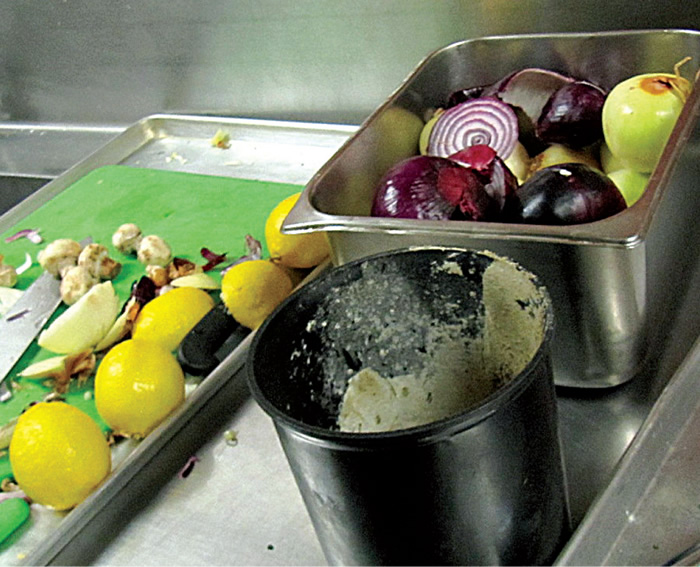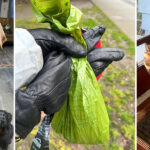Joint Base Lewis-McChord planted the seeds for net zero waste in the early 2000s. Food scraps collection from dining halls and a commissary is helping push the needle. Part I
Ashley Blazina
BioCycle June 2015
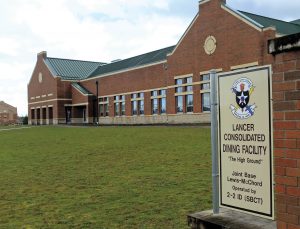
The Lancer Dining Facility is the largest food service operation on the base, providing meals to 700 servicemembers per day.
Joint Base Lewis-McChord (JBLM) in western Washington, near the city of Tacoma, is a beacon of sustainability among military bases across the country. With a population of over 139,000 (about 42,000 servicemembers, 54,000 family members, retirees and civilians), the base is the seventh-largest city in the State of Washington, and has developed dynamic systems for composting, construction materials reuse, recycling and energy efficiency that rival the “greenest” metropolises in the United States.
The groundwork for JBLM’s sustainability initiatives was laid in 2001, when the then-Fort Lewis was asked by Army Headquarters to help develop the Army’s Sustainability Program by refining processes on the base. (JBLM was established in 2010 when Fort Lewis became a joint base with McChord Air Force Base.) In 2002, Fort Lewis collected data on its current resource use, including amounts of waste, gallons of water, and kilowatts per hour used. The base’s first large-scale refuse and recycling contract was awarded in 2002. That year, Fort Lewis finalized goals for reducing air emissions, energy, materials and water use, e.g., reducing water consumption by 75 percent by 2025 and developing cycles for all waste streams to achieve a zero waste status by 2025. Goals were reevaluated in 2007 and again in 2011, after the Assistant Secretary of the Army directed the establishment of Net Zero in October 2010 (see sidebar).
This two-part article focuses primarily on JBLM’s zero waste initiatives — specifically organics recycling and composting. Part I covers the programs established to source separate organics. Part II reports on JBLM’s composting operation, as well as the innovative techniques the base uses to promote compost utilization.
Waste Reduction Champions
Outlining its sustainability goals and developing the refuse and recycling plan in 2002 were fortuitous as the last landfill on the Fort Lewis base closed in 2004. Ken Smith, Chief of the Environmental Operations Branch of the base’s Directorate of Public Works (DPW), and Ron Norton, JBLM’s DPW Solid Waste and Recycling Program manager, scribbled out a rough sketch for an on-base composting facility, where all food waste could be processed and the compost reused for landscaping, gardening and other projects throughout the JBLM community. The main driver was the cost to haul waste off the base for disposal — cost per ton in 2004 was $140 (currently the cost is about $180/ton). Hence, the Earthworks composting facility was born, sited atop a former Army landfill.
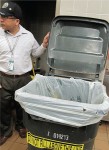
The high turnover rate of new personnel requires continual education about reduction of wasted food and source separation, notes Lancer’s Dining Facility Contracting Officer Rep. Ben Tesoro.
Although some technical challenges were encountered, the largest issue the Earthworks team had to overcome was convincing base personnel to separate organics for composting. “The biggest thing was the culture change that needed to occur to convince people that this would even work,” explains Smith. “Fortunately, we had a lot of good leadership that believed in sustainability. Then, when you get the benefit of a product you [now] don’t have to buy, it’s a win-win.”
To achieve the necessary changes in terms of net zero waste, JBLM has relied on a few of its base champions — partners throughout the base who have helped inspire other dining facilities and commissaries to further develop their own source separation and composting practices. The Lancer Dining Facility, the largest food service operation on the base, is a case in point. It serves more than 700 servicemembers per day. With such a high volume of soldiers coming through, efficiency is key, which is one reason why Lancer’s Dining Facility Contracting Officer Representative (COR) Ben Tesoro has hooked into composting and recycling at the facility. “With the [Net Zero] plan, you have to find one champion [for every department],” explains Shelia Martin, JBLM’s recycling outreach coordinator. “With people like Ben, who are willing to make a commitment to the program, you give them the tools, [knowing] the costs savings for the government.”
Food prep and cooking teams collect all of their produce, meat, dairy and bread waste into individual organics-designated bins. To make separation more convenient, foodservice employees can select bins that are most conducive to their particular station. One produce station, for example, uses a small round bucket atop the food bench, while the meat section needs a much larger bin for unusable trim and scraps of beef, pork or chicken. After each meal, employees in the dishwashing units separate out all scraps from the used trays into compostable, recyclable and waste materials.
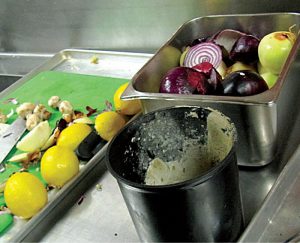
To make separation more convenient, foodservice employees can select bins that are most conducive to their particular stations. For example, a produce station uses a small round bucket atop the food bench. Photo by Ashley Blazina
With servicemembers coming to JBLM from across the country, Tesoro knows that some people — both Lancer staff and army personnel — may need a little more convincing than others to separate out the organics. For some, it is a completely foreign concept. With the high turnover rate of new personnel coming in and out, the education process has to be repeated regularly, which can lead to some frustration. For example, as he examined the contents of one organics bin, Tesoro couldn’t help but scowl. “Look at these bananas!” he exclaimed, pointing to a full bunch of the browning yellow fruits. “These bananas could have been used for banana bread or something!”
Martin adds that she uses skills she’d never expect to before taking her job as Recycling Coordinator. For example, she speaks Korean, and at Lancer, some of the women in the dishwashing department are Korean. Martin was able to explain separation procedures in their native language, gaining their trust and cooperation. “By definition, you have to improvise,” she says. “You need to utilize different tools.”
Tackling The Commissary
While Tesoro develops opportunities for waste diversion in the dining facilities, Janet Landon, manager of the Lewis Main Commissary, has become a national beacon of waste reduction techniques for military base commissaries. She first got into waste diversion after going over the commissary’s budgets and seeing how much could be saved by recycling cardboard versus throwing it away. Landon quickly changed waste protocols at the store.
She then moved onto food waste, but came up against a hurdle. She called a number of area farmers to inquire about their possible interest in and ability to compost the food scraps. Farmer interest and capabilities didn’t match the volume of waste that the produce, bakery, deli and other store departments generate daily. Although Landon regularly inventories and tracks orders for every department to reduce unnecessary waste, she still needed a central location for the waste produced through prep services. Serendipity struck when Landon was in a meeting with Smith and Norton, who were just starting to look for large suppliers of food material for the Earthworks composting center.
Today, the Lewis Main Commissary diverts organics from all store departments — from chicken fat to fruit rinds. Prior to organics diversion, Lewis Main had its garbage picked up three times per week. Today, its trash compactor is serviced every two weeks, and sometimes, it’s only partially full. By that point, the smell is more of an issue than anything, notes Landon.
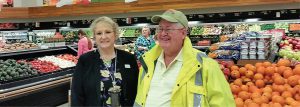
Janet Landon, manager of the Lewis Main Commissary (left), pictured here with James Lee, manager of JBLM’s Qualified Recycling Program, has become a national beacon of waste reduction techniques for military base commissaries. Photo by Ashley Blazina
She has also made the compostables bins the most available form of receptacle. They are centrally located to all store departments. Recycling containers flank the compostables bins, and at the very far end sits the garbage compactor. “We found the closer we put a bin to a work area, the more likely [workers] are to use it,” she explains.
Although this system has worked well for the most part, there have been issues in the past, which Landon has not shied away from correcting. After a two-week vacation, she found the trash compactor unexpectedly full, and so she personally picked through it. After finding trash from every commissary department, she brought individuals from all departments to the compactor to see what should have been recycled or composted. On the rare occasion when Martin has alerted Landon to contamination in food waste from Lewis Main Commissary, she identifies the individuals responsible, and schedules a trip to Earthworks. “She’s actually asked me to hold the stuff, brought her work crew to the facility and physically gone through the trash,” explains Martin. “That set the precedent for the Commissary facility. It has the highest rate of diversion and the lowest rate for contamination.”
Landon’s unforgiving stance on reducing waste streams has made her commissary a legend in budgeting as well. “There are a number of people who like to say, ‘It’s too hard, it doesn’t cost out,’” notes James Lee, manager of JBLM’s Qualified Recycling Program. “We show them Janet’s numbers, and say, ‘Oh, yes, it does.’ Because of the Janet Landons of the world, we know they can.”
Working Toward Net Zero
Despite being surrounded by an overall culture in support of Net Zero, JBLM still knows it has a ways to go before it can reach its final goal. For example, there are still many waste streams that can be diverted to composting, including postconsumer waste. To better develop its programs, JBLM is looking at success stories from around the country. At a recent conference, JBLM Commanding Officer Colonel H. Charles Hodges saw a number of innovative technologies that he hopes will complement the base’s current initiatives, especially in terms of energy efficiency. Hodges would also like to implement better single- family recycling options.
The recycling team at JBLM notes that one of its largest challenges in terms of Net Zero waste is working with building and infrastructure designed around nonsustainable practices. Some buildings date back to the early 1920s, and have narrow roadways, lack of access ramps and a number of awkward truck parking additions — all making the physical realities of the Net Zero waste goal challenging on a daily basis. “We hope that someday, design and construction options will be considered with sustainability in mind,” notes Lee.”Until then, we’re stuck doing it the hard way, improvising as we go. But we’re not going to go back and say, ‘So, we tried Net Zero, and it’s just not working.’ That’s not an option for us.”
Ashley J. Blazina, a Contributing Writer to BioCycle, is a Master of Forest Sciences Candidate (2016) at the University of Washington.


